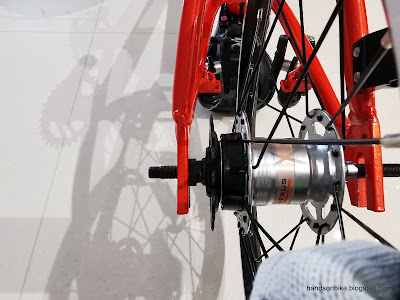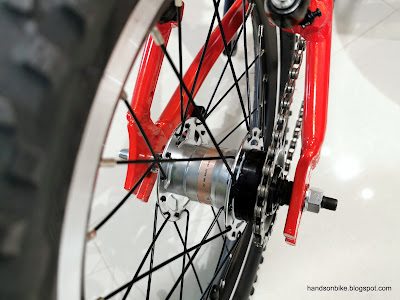With the new 3 speed drivetrain on the Bestrider Pump Pro 16 completed, what is left is to put on the pedals for a test ride.
This bike came with pretty crappy pedals, so I had to get a better set of kids pedals for this bike. As discovered on the Early Rider Seeker 14, the Early Rider pedals are really good pedals, with smooth bearings and high quality finishing.
It is hard to find good aftermarket pedals for kids, as most that I have seen are cheap plastic ones that hardly even spin. Finally I managed to find these Early Rider pedals, but they are rather expensive.
New set of Early Rider pedals!
With sealed bearings, they spin smoothly.
133 grams per side, giving a weight of 266 grams per pair.
Pedals installed on the Bestrider bike! After installation, I found that the pedals look a bit big relative to the crankarm.
Upon side by side comparison of the Early Rider pedals of the Seeker 14 and the new set, I found that the new pedals are larger!
So these are not the same pedals as those that came stock on the Early Rider Seeker 14. However, they look similar and are of the same high quality. I guess the larger platform means that it can be used even when the kid's feet grow bigger.
Upgraded bike! Can you spot the changes?
Nexus 3 speed internal hub installed on the bike.
Bell crank protrudes from the frame, but it can't be helped.
Cable routing is a little messier due to the additional shifting cable from the shifter.
2 finger braking is OK!
On the left side with no shifter, 3 finger braking is possible.
However, 2 finger braking is preferred, to be symmetrical with the right side.
Comparison with the Early Rider Seeker 14, after the upgrade.
On the previous comparison before the upgrade, the stock handlebar on the Pump Pro 16 was really high, even more than this.
Comparison of the handlebar area
Comparison of the drivetrain and rear wheel area. No more belt drive.
Under sunlight, the red paint on the new bike looks stunning.
The glitter in the paint looks really good.
Another picture showing the high quality of the paint job.
3 speed internal hub drivetrain!
Finally, let's compare the weight of the different setups.
Early Rider Seeker 14 (Single Speed, Belt Drive)
5.7 kg without pedals and kickstand, in stock condition.
About 6 kg with Early Rider pedals (200 g) and kickstand (~100 g).
Bestrider Pump Pro 16 (Single Speed)
5.6 kg without pedals and kickstand, in stock condition.
About 6 kg with larger Early Rider pedals (266 g) and kickstand (102 g).
Bestrider Pump Pro 16 (3 Speed)
After upgrading to 3 speed drivetrain, it is 6.4 kg without pedals and kickstand.
6.8 kg with Early Rider pedals (266 g) and kickstand (102 g).
This is also with carbon handlebar, Dura-Ace chain, new grips, etc.
In summary, this bike is now 6.8 kg after the 3 speed drivetrain upgrade. This upgrade added about 800 grams to the bike weight, including the offset from the lighter carbon handlebar, etc.
Is this additional 800 grams worth the 3 speed drivetrain? In this case, I think so, as 6.8 kg is still very light for a kids bike. Almost all other kids bike with a single speed drivetrain weigh more than this.
This 3 speed drivetrain means that there is always a low gear for climbing slopes, while gears 2 and 3 are for cruising on flat ground or even some sprinting. Overall, I am very happy with this new kids bike.





























































